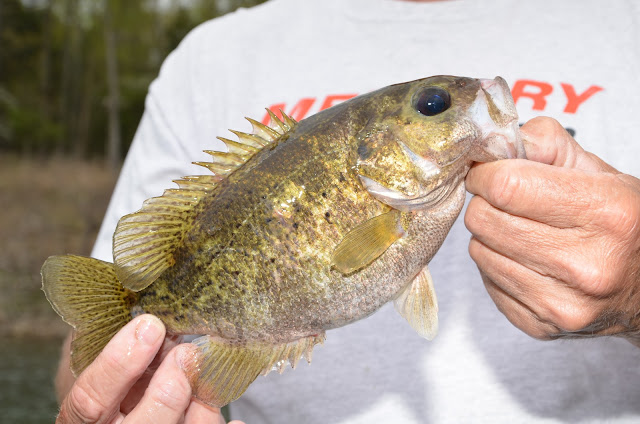 |
| The deep dark waters of the bell rock eddy awaited us as an afternoon storm warned us away. |
Squire Lee was an old country gentleman who lived on a sloping hillside above the river. His home was not far from the little cabin where my dad spent much of his childhood. In the river below his old two-story home was a deep eddy with a giant rock sticking out of it. Dad and I always had permission to drive through Mr. Lee’s land to fish there. Some 20 to 40 pound flathead catfish had been taken from the river around the big rock.
In May of 1964 I had turned 16 years old and could drive my dad’s old 1950 pickup. So one Saturday in May of ’64 I, and brothers Tom and Roy Wayne Morton, cooked up a trotlining trip. We had a canvas tarpaulin that would cover the rack on the pickup and I found an old mattress in Grandpa McNew’s barn. We could sleep periodically in the bed of the truck while running trotlines during the night. So we put the mattress in first, then the johnboat, and then loaded gear and groceries and headed for the river to yank out some of those flathead catfish. The Morton brothers and I seldom got too skip church on Sunday unless it was for fishing. Proclaiming sickness didn’t always work. So we were awfully happy that Saturday morning bouncing toward the river in that old pickup with the sun shining brightly and birds singing from the roadsides. Most 16-year-old boys back then were looking forward to taking a girl to the movies on Saturday night but not me. I was addicted to the river! Not only that, I wasn’t blessed with the finances for such a Saturday night, nor was I blessed with the looks to convince a girl too go with me to the movies even if I found a free one! We drove down past squire Lees big old two-story home to the river bottom where we unloaded the boat beneath a big old sycamore and set up camp. We had ourselves a baloney sandwich with an RC Cola and some chocolate cupcakes and then loaded the trotline gear to head downriver.
The first rumble of thunder came while we were seining minnows about 500 yards downstream from the pickup two hours later. Just after that, the darkening skies told me to retreat to the big cave above the river nearby. Flashes of lightning to the southwest began to worry me. We pulled the old johnboat way up on the bank and tied it, and I headed up the slope behind Tom and Roy Wayne. Halfway there I encountered an old barbwire fence and straddled it in my wet swimsuit and wet shoes. Just then a bolt of lightning streaked down upstream from where we were and I felt numb all over as I tried to get myself up off the ground. I realized that I had been the victim of a lightning strike and I realized that while I was hurting everywhere… I wasn’t dead! I had remembered Ol’ Bill and Ol’ Jess at the pool hall talking about how a lightning bolt didn’t always kill a feller and that in the aftermath of such a calamity, folks who lived was sometimes reduced to being not as smart as they were or much smarter than they had been. I am not sure that a kid who would reach out and grab a fence in a lightnin’ storm could get much dumber. The proof that I was smarter could be seen in the rapidness with which I gained the awaiting cave shelter, where I quickly started going over algebraic equations I never thought I would remember. And another thing I remember is that my long hair from that time had lifted my cap up an inch or two above my forehead. So there we were a good quarter mile below our camp at Squire Lee’s home in a raging storm about midway through what had been a great Saturday afternoon. Decisions had to be made. Thankfully we had covered our mattress with the tarp so it should remain dry, as well as our quilts, stored in garbage bags. BUT… if the river rose ten feet it would reach the back of the pickup and all our breakfast eggs and baloney and Little Debbie cupcakes would be washed down the river. I was more worried about that truck of dads. If it got washed down the river, I would just as well go with it. On the bravery side I could leave Tom and Roy Wayne and get in the boat and paddle upriver against the rising current in that storm, dodging broken limbs and lightning bolts and move the pickup, if it wasn’t stuck in the mud. On the not-so-brave-but-smarter side I could stay in the safety of the dry secure cave. Would my as yet unseen bravery come through or would I use the increased intelligence that lightning bolt had given me and stay put. In next weeks column you can read the exciting conclusion to this true account of the storm on the river. |



